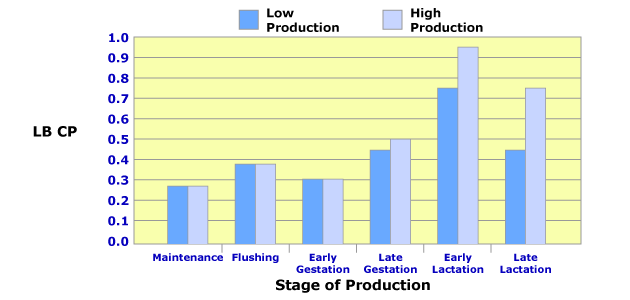Previous Page | Right click this page to print.
Protein
Let's talk a little bit about protein then. And from the standpoint of protein, quantity is more important than quality. Again, because they are ruminants, they can take care of the quality from the standpoint of microbial synthesis. To get at the quality then we rely on rumen microbial activity. And, in most situations, lush pastures, good quality pasture, high quality hays, will serve as adequate protein sources. When you are doing and balancing diets, for especially sheep, like ewes, if you have good quality hay, you can have adequate protein. Protein generally isn’t a nutrient that you have to be too concerned with except if you’re trying to balance utilizing Willamette Valley, western Oregon grass hays because they are very low in protein, but quality hay, some legumes, no problem. But if you have these poorer quality hays, then you are going to have to provide some supplemental protein to meet the needs. But in most cases, good quality roughages, pastures, what have you, will take care of the protein needs.
If we look at the same scheme, from the standpoint of crude protein requirements, again, no differences.
Crude Protein Requirements for a 176 lb Ewe

About a quarter of a pound, little bit higher for flushing, but around a quarter of a pound, three-tenths of a pound early gestation. Late lactation, protein requirement goes up to about a half a pound. Then, for lactation with twins, we’re up close to one pound per head per day. Milk production, we need to have the protein, but if we are feeding good quality hays, this will be met. Legume hays, we can take care of that protein need. The only thing we probably are going to have to supplement would be some energy sources. Then, of course, it goes down.
Based on a rule of thumb that I always use for energy, about 4 lbs, 4.5 lbs of energy during lactation for twins, about 3 lbs for late gestation, about 2.5 for the other times. Protein, about a one quarter of a pound down in here, a quarter to three-tenths, about half a pound here and then a pound here. Those are some kind of ballpark figures I use from the standpoint of evaluating rations when you look at the requirement over the spectrum. The most it's going to take is about a pound of protein, crude protein, per head per day. And 4-4.5 lbs of that, of their intake is going to have to be in the form of energy during that lactation period. And then it's going to be downward from there on. When it comes to protein, then I remember a quarter of a pound, a half a pound, a pound. And with energy, starting on top at the most extreme time, about 4-4.5, 3-3.5, 2.5-3, and the other times. And that pretty well is really all you need to know about feeding sheep from the standpoint of quickly evaluating adequacy of rations.
Previous Page | Right click this page to print.